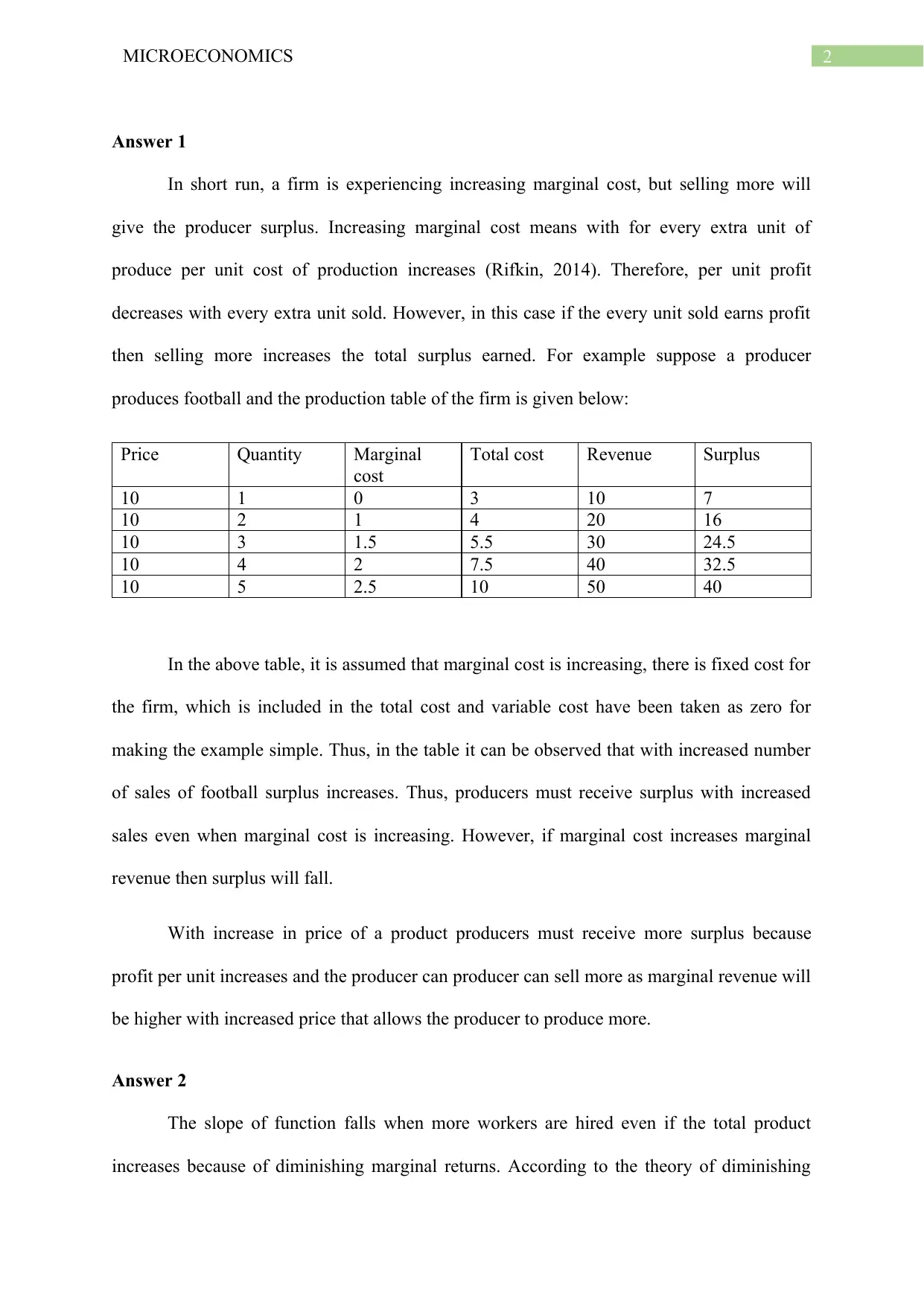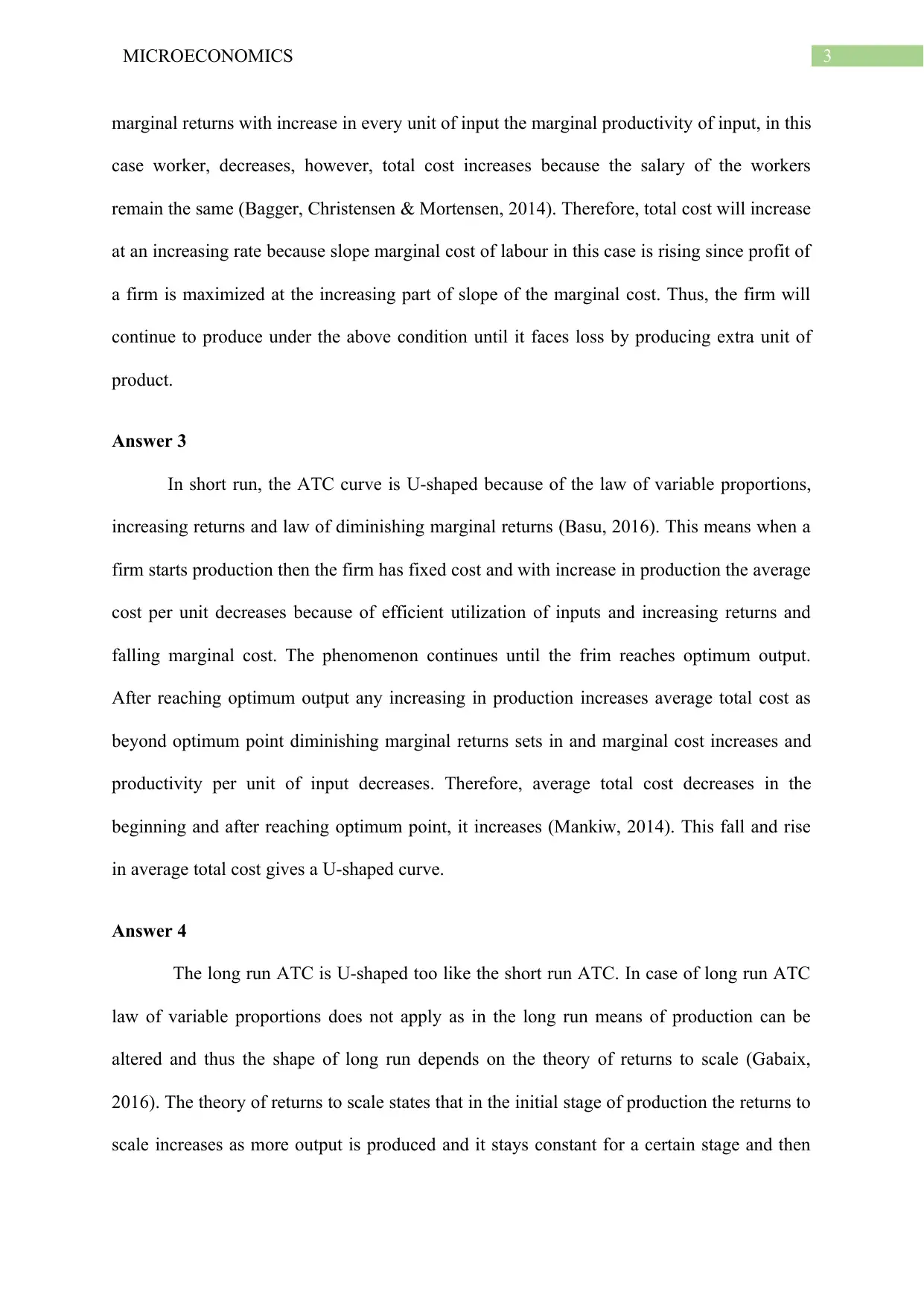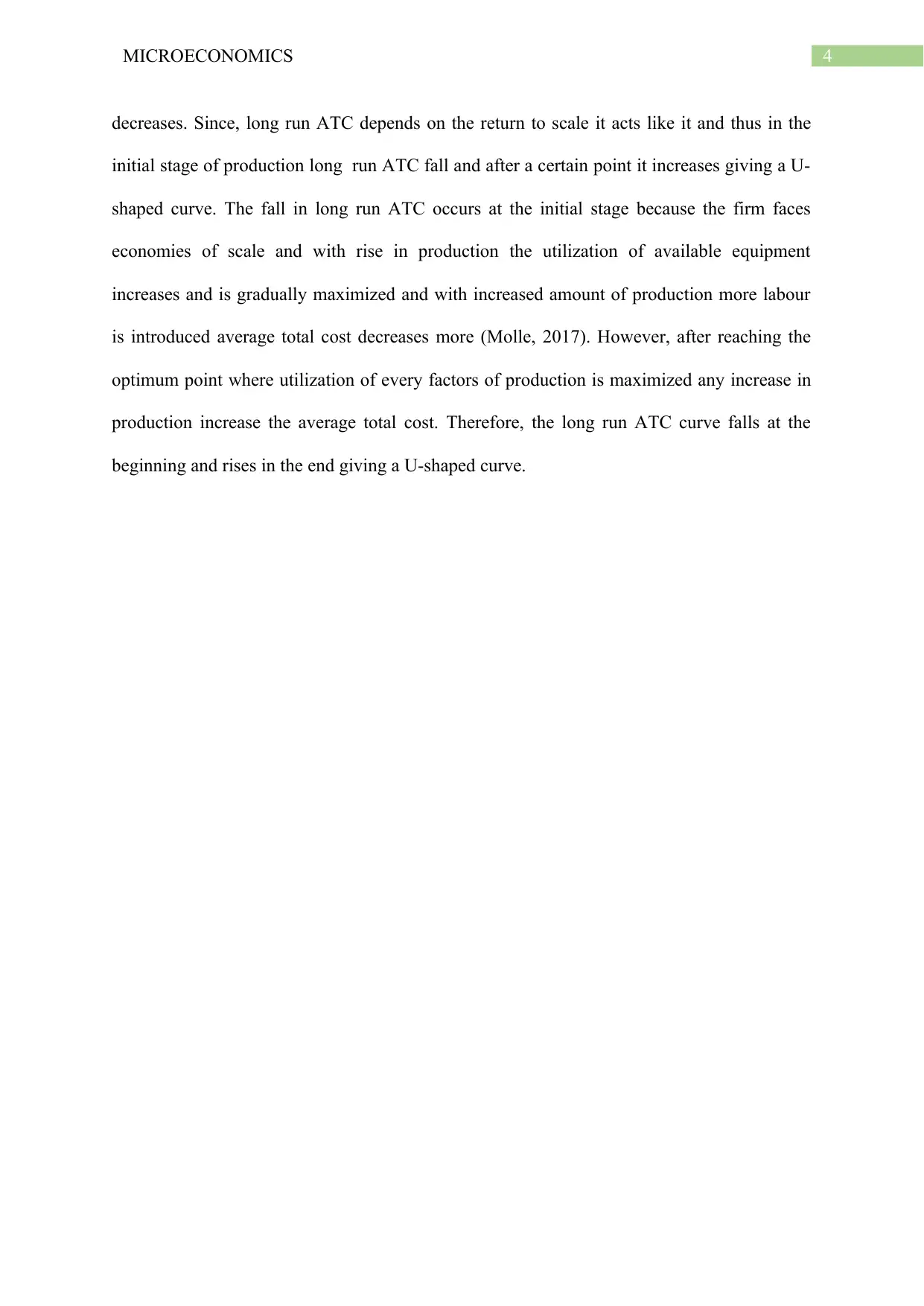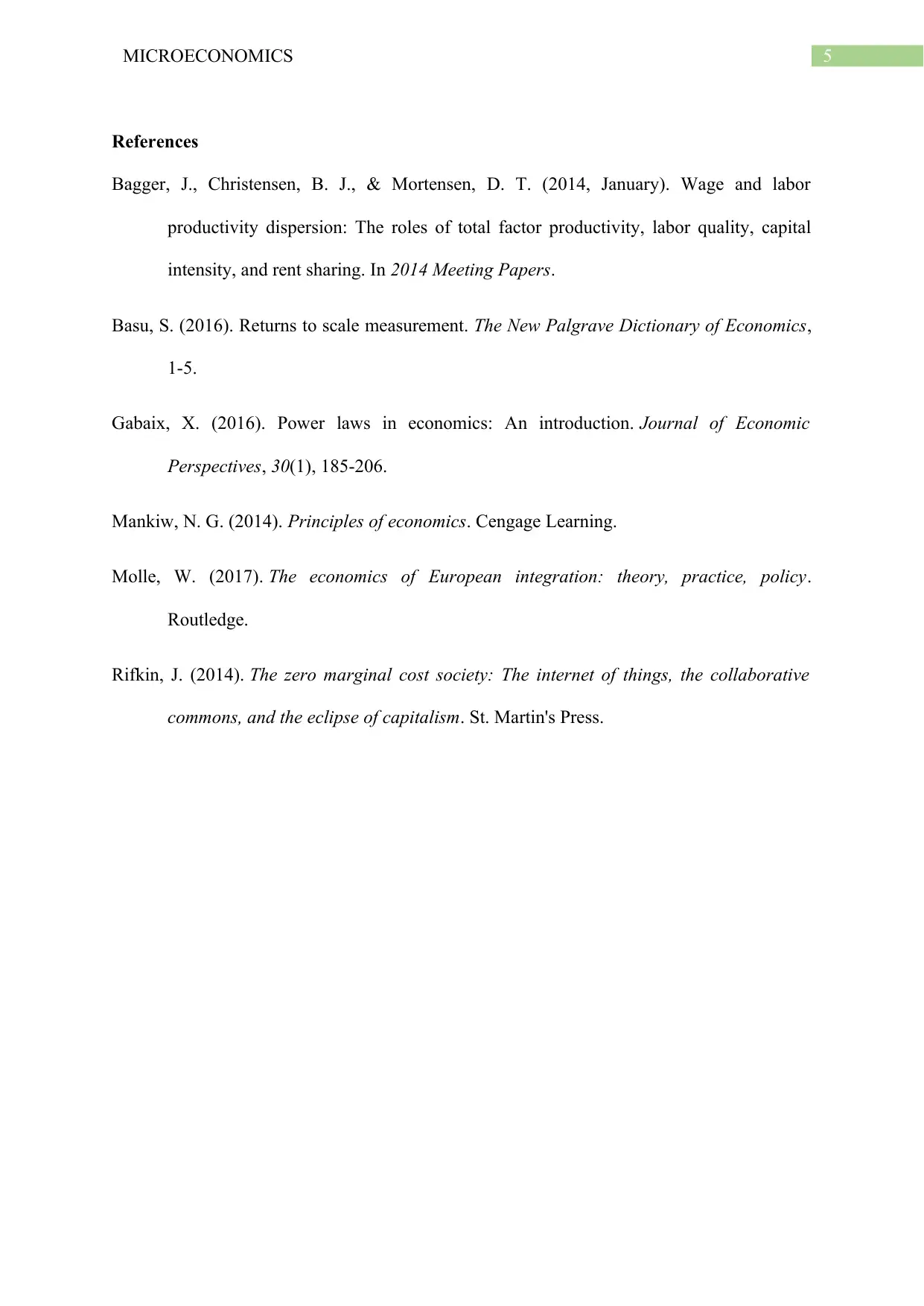Microeconomics Assignment: Firm Behavior and Production Costs
VerifiedAdded on 2022/10/10
|6
|997
|192
Homework Assignment
AI Summary
This microeconomics assignment analyzes key concepts related to firm behavior and market dynamics. The assignment addresses topics such as producer surplus in the short run, explaining how firms can still earn a surplus even with increasing marginal costs. It provides a numerical example to illustrate this principle. The solution also explains how the slope of a production function falls as more workers are hired due to diminishing marginal returns, which impacts the total cost curve. Furthermore, the assignment explores the U-shaped nature of both short-run and long-run Average Total Cost (ATC) curves, linking it to the laws of variable proportions, returns to scale, and economies of scale. The document provides a detailed explanation of the factors causing the ATC curves to initially fall and then rise as output changes.

Running head: MICROECONOMICS
Microeconomics
Name of the Student
Name of the University
Student ID
Microeconomics
Name of the Student
Name of the University
Student ID
Paraphrase This Document
Need a fresh take? Get an instant paraphrase of this document with our AI Paraphraser

1MICROECONOMICS
Table of Contents
Answer 1....................................................................................................................................2
Answer 2....................................................................................................................................2
Answer 3....................................................................................................................................3
Answer 4....................................................................................................................................3
References..................................................................................................................................5
Table of Contents
Answer 1....................................................................................................................................2
Answer 2....................................................................................................................................2
Answer 3....................................................................................................................................3
Answer 4....................................................................................................................................3
References..................................................................................................................................5

2MICROECONOMICS
Answer 1
In short run, a firm is experiencing increasing marginal cost, but selling more will
give the producer surplus. Increasing marginal cost means with for every extra unit of
produce per unit cost of production increases (Rifkin, 2014). Therefore, per unit profit
decreases with every extra unit sold. However, in this case if the every unit sold earns profit
then selling more increases the total surplus earned. For example suppose a producer
produces football and the production table of the firm is given below:
Price Quantity Marginal
cost
Total cost Revenue Surplus
10 1 0 3 10 7
10 2 1 4 20 16
10 3 1.5 5.5 30 24.5
10 4 2 7.5 40 32.5
10 5 2.5 10 50 40
In the above table, it is assumed that marginal cost is increasing, there is fixed cost for
the firm, which is included in the total cost and variable cost have been taken as zero for
making the example simple. Thus, in the table it can be observed that with increased number
of sales of football surplus increases. Thus, producers must receive surplus with increased
sales even when marginal cost is increasing. However, if marginal cost increases marginal
revenue then surplus will fall.
With increase in price of a product producers must receive more surplus because
profit per unit increases and the producer can producer can sell more as marginal revenue will
be higher with increased price that allows the producer to produce more.
Answer 2
The slope of function falls when more workers are hired even if the total product
increases because of diminishing marginal returns. According to the theory of diminishing
Answer 1
In short run, a firm is experiencing increasing marginal cost, but selling more will
give the producer surplus. Increasing marginal cost means with for every extra unit of
produce per unit cost of production increases (Rifkin, 2014). Therefore, per unit profit
decreases with every extra unit sold. However, in this case if the every unit sold earns profit
then selling more increases the total surplus earned. For example suppose a producer
produces football and the production table of the firm is given below:
Price Quantity Marginal
cost
Total cost Revenue Surplus
10 1 0 3 10 7
10 2 1 4 20 16
10 3 1.5 5.5 30 24.5
10 4 2 7.5 40 32.5
10 5 2.5 10 50 40
In the above table, it is assumed that marginal cost is increasing, there is fixed cost for
the firm, which is included in the total cost and variable cost have been taken as zero for
making the example simple. Thus, in the table it can be observed that with increased number
of sales of football surplus increases. Thus, producers must receive surplus with increased
sales even when marginal cost is increasing. However, if marginal cost increases marginal
revenue then surplus will fall.
With increase in price of a product producers must receive more surplus because
profit per unit increases and the producer can producer can sell more as marginal revenue will
be higher with increased price that allows the producer to produce more.
Answer 2
The slope of function falls when more workers are hired even if the total product
increases because of diminishing marginal returns. According to the theory of diminishing
⊘ This is a preview!⊘
Do you want full access?
Subscribe today to unlock all pages.

Trusted by 1+ million students worldwide

3MICROECONOMICS
marginal returns with increase in every unit of input the marginal productivity of input, in this
case worker, decreases, however, total cost increases because the salary of the workers
remain the same (Bagger, Christensen & Mortensen, 2014). Therefore, total cost will increase
at an increasing rate because slope marginal cost of labour in this case is rising since profit of
a firm is maximized at the increasing part of slope of the marginal cost. Thus, the firm will
continue to produce under the above condition until it faces loss by producing extra unit of
product.
Answer 3
In short run, the ATC curve is U-shaped because of the law of variable proportions,
increasing returns and law of diminishing marginal returns (Basu, 2016). This means when a
firm starts production then the firm has fixed cost and with increase in production the average
cost per unit decreases because of efficient utilization of inputs and increasing returns and
falling marginal cost. The phenomenon continues until the frim reaches optimum output.
After reaching optimum output any increasing in production increases average total cost as
beyond optimum point diminishing marginal returns sets in and marginal cost increases and
productivity per unit of input decreases. Therefore, average total cost decreases in the
beginning and after reaching optimum point, it increases (Mankiw, 2014). This fall and rise
in average total cost gives a U-shaped curve.
Answer 4
The long run ATC is U-shaped too like the short run ATC. In case of long run ATC
law of variable proportions does not apply as in the long run means of production can be
altered and thus the shape of long run depends on the theory of returns to scale (Gabaix,
2016). The theory of returns to scale states that in the initial stage of production the returns to
scale increases as more output is produced and it stays constant for a certain stage and then
marginal returns with increase in every unit of input the marginal productivity of input, in this
case worker, decreases, however, total cost increases because the salary of the workers
remain the same (Bagger, Christensen & Mortensen, 2014). Therefore, total cost will increase
at an increasing rate because slope marginal cost of labour in this case is rising since profit of
a firm is maximized at the increasing part of slope of the marginal cost. Thus, the firm will
continue to produce under the above condition until it faces loss by producing extra unit of
product.
Answer 3
In short run, the ATC curve is U-shaped because of the law of variable proportions,
increasing returns and law of diminishing marginal returns (Basu, 2016). This means when a
firm starts production then the firm has fixed cost and with increase in production the average
cost per unit decreases because of efficient utilization of inputs and increasing returns and
falling marginal cost. The phenomenon continues until the frim reaches optimum output.
After reaching optimum output any increasing in production increases average total cost as
beyond optimum point diminishing marginal returns sets in and marginal cost increases and
productivity per unit of input decreases. Therefore, average total cost decreases in the
beginning and after reaching optimum point, it increases (Mankiw, 2014). This fall and rise
in average total cost gives a U-shaped curve.
Answer 4
The long run ATC is U-shaped too like the short run ATC. In case of long run ATC
law of variable proportions does not apply as in the long run means of production can be
altered and thus the shape of long run depends on the theory of returns to scale (Gabaix,
2016). The theory of returns to scale states that in the initial stage of production the returns to
scale increases as more output is produced and it stays constant for a certain stage and then
Paraphrase This Document
Need a fresh take? Get an instant paraphrase of this document with our AI Paraphraser

4MICROECONOMICS
decreases. Since, long run ATC depends on the return to scale it acts like it and thus in the
initial stage of production long run ATC fall and after a certain point it increases giving a U-
shaped curve. The fall in long run ATC occurs at the initial stage because the firm faces
economies of scale and with rise in production the utilization of available equipment
increases and is gradually maximized and with increased amount of production more labour
is introduced average total cost decreases more (Molle, 2017). However, after reaching the
optimum point where utilization of every factors of production is maximized any increase in
production increase the average total cost. Therefore, the long run ATC curve falls at the
beginning and rises in the end giving a U-shaped curve.
decreases. Since, long run ATC depends on the return to scale it acts like it and thus in the
initial stage of production long run ATC fall and after a certain point it increases giving a U-
shaped curve. The fall in long run ATC occurs at the initial stage because the firm faces
economies of scale and with rise in production the utilization of available equipment
increases and is gradually maximized and with increased amount of production more labour
is introduced average total cost decreases more (Molle, 2017). However, after reaching the
optimum point where utilization of every factors of production is maximized any increase in
production increase the average total cost. Therefore, the long run ATC curve falls at the
beginning and rises in the end giving a U-shaped curve.

5MICROECONOMICS
References
Bagger, J., Christensen, B. J., & Mortensen, D. T. (2014, January). Wage and labor
productivity dispersion: The roles of total factor productivity, labor quality, capital
intensity, and rent sharing. In 2014 Meeting Papers.
Basu, S. (2016). Returns to scale measurement. The New Palgrave Dictionary of Economics,
1-5.
Gabaix, X. (2016). Power laws in economics: An introduction. Journal of Economic
Perspectives, 30(1), 185-206.
Mankiw, N. G. (2014). Principles of economics. Cengage Learning.
Molle, W. (2017). The economics of European integration: theory, practice, policy.
Routledge.
Rifkin, J. (2014). The zero marginal cost society: The internet of things, the collaborative
commons, and the eclipse of capitalism. St. Martin's Press.
References
Bagger, J., Christensen, B. J., & Mortensen, D. T. (2014, January). Wage and labor
productivity dispersion: The roles of total factor productivity, labor quality, capital
intensity, and rent sharing. In 2014 Meeting Papers.
Basu, S. (2016). Returns to scale measurement. The New Palgrave Dictionary of Economics,
1-5.
Gabaix, X. (2016). Power laws in economics: An introduction. Journal of Economic
Perspectives, 30(1), 185-206.
Mankiw, N. G. (2014). Principles of economics. Cengage Learning.
Molle, W. (2017). The economics of European integration: theory, practice, policy.
Routledge.
Rifkin, J. (2014). The zero marginal cost society: The internet of things, the collaborative
commons, and the eclipse of capitalism. St. Martin's Press.
⊘ This is a preview!⊘
Do you want full access?
Subscribe today to unlock all pages.

Trusted by 1+ million students worldwide
1 out of 6
Related Documents
Your All-in-One AI-Powered Toolkit for Academic Success.
+13062052269
info@desklib.com
Available 24*7 on WhatsApp / Email
![[object Object]](/_next/static/media/star-bottom.7253800d.svg)
Unlock your academic potential
Copyright © 2020–2025 A2Z Services. All Rights Reserved. Developed and managed by ZUCOL.





